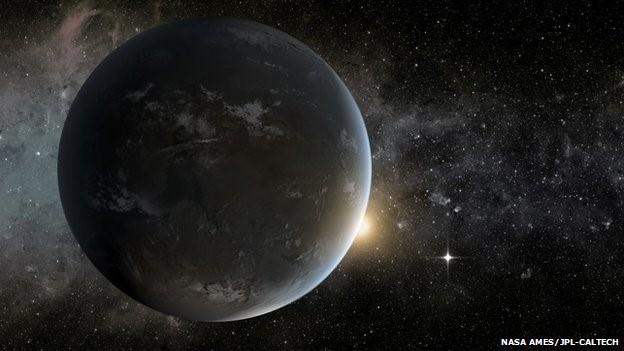Plato planet-hunter in pole position
- Published
A telescope to find thousands of planets beyond our Solar System is the hot favourite for selection as Europe's next medium-class science mission.
Known as Plato, external, the concept was chosen by an expert panel as the standout candidate in a competition run by the European Space Agency (Esa).
The Paris-based organisation's Science Policy Committee will now have the final say at its meeting in February.
If given the go-ahead, Plato would probably not launch until 2024.
The name of the mission is an acronym that stands for PLAnetary Transits and Oscillations of stars.
It is not really one telescope but rather a suite of 34 telescopes mounted on a single satellite.
The intention is for Plato to sweep about half the sky, to investigate some of its brightest and nearest stars.
It would monitor these stars for the tell-tale tiny dips in light that occur when planets move across their faces.
Critically, Plato would be tuned to seek out rocky worlds orbiting in the "habitable zone" - the region around a star where water can keep a liquid state.
A fundamental part of its quest would be to perform an intricate study of the host stars themselves, using their pulsations to probe their structure and properties.
Such observations, referred to as asteroseismology, would provide key, complementary information for the proper characterisation of the rocky worlds.
Although other missions have pursued this kind of science before, Plato is described as a major leap forward in capability.
The hope is that it could find really promising targets for follow-up by the big ground-based telescopes due to come online in the next decade.
These facilities, which will have primary mirrors measuring tens of metres in diameter, should be able to examine the atmospheres of distant worlds for possible life signatures.
The James Webb Space Telescope, the successor to Hubble, due for launch at the end of this decade, would likely still be working in 2024/2025 and could also pursue Plato's discoveries.

The goal is to find planets like the Earth, not just in terms of their size but in their potential for habitability
Plato has spent the past two years in an assessment process that has pitted it against four other concepts.
These alternatives included another planet observatory (Echo), external, an asteroid mission (Marco Polo-R), external, an X-ray telescope (Loft), external, and a satellite that would perform a precise test of Einstein's equivalence principle (STE-Quest), external.
All were vying for the third medium-class launch opportunity to be offered under Esa's so-called Cosmic Vision programme, which defines the organisation's space science priorities.
"Medium class" means a cost to the agency of no more than about 600m euros (£490m; $820m), although following the practice of previous missions this does not include the budget for instruments.
These are usually provided directly by Esa's national member agencies and mean the final price tag can approach one billion euros.
All the competitors were invited to make a final presentation to representatives of the scientific community, industry, and national member agencies on 21 January. This was followed by closed-session discussions by two working groups, which rated the quality of the missions.
Their recommendations were then passed to Esa's top space science advisory committee (SSAC) to make an evaluation.
It proposed that Plato be carried forward as the mission of choice, and this preference has now been sent on by Esa's executive to the SPC. The committee has the prerogative of "selection" at its 19 February gathering, and could still reject Plato - but this would be a major surprise.
The final green light is known as "adoption" in Esa-speak. This is unlikely to happen until 2015, after member states have made firm commitments on their participation and an industrial team to build the satellite has been identified.
One big industrial contribution from the UK seems assured. This would be the camera detector at the base of the telescope suite.
Supplied by e2v in Chelmsford, the array of more than 130 charge-coupled devices would be 0.9 square metres in area.
This would make it the largest camera system ever flown in space, and twice the size of the array e2v produced for Esa's recently launched Gaia telescope.
The first two medium-class missions to be selected under Esa's Cosmic Vision programme in 2011 were Solar Orbiter, a space telescope to study the Sun, to launch in 2017; and Euclid, a telescope to investigate "dark energy", to fly in 2020.
The American space agency (Nasa) plans a similar mission to Plato called Tess (Transiting Exoplanet Survey Satellite), external in 2017, but the specifications mean that its rocky worlds will probably be in closer orbits around lower-mass stars than the discoveries made by the European project. In other words, the Plato planets are more likely to be in the habitable zones of more Sun-like stars.
Jonathan.Amos-INTERNET@bbc.co.uk and follow me on Twitter: @BBCAmos, external
- Published28 November 2013
- Published2 May 2012
- Published20 June 2012
- Published4 October 2011